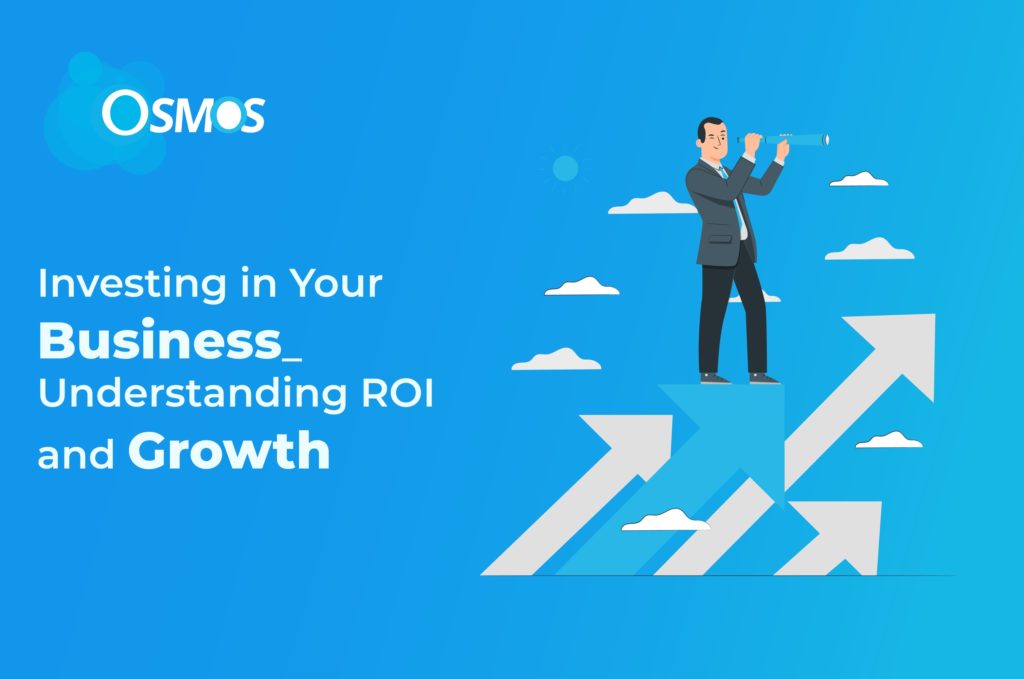Are you ready to take your business to the next level? Learn about return on investment (ROI) and how it can drive growth in your business.
Investing in your business is an ongoing process that requires strategic thinking, careful analysis, and continuous evaluation.
Understanding ROI is essential for investment decisions, prioritizing initiatives, and maximizing profitability.
By setting clear goals, conducting thorough market research, diversifying investments, and embracing technology, you can increase your chances of achieving a higher ROI and growth.
You also need to track key metrics such as:
- Revenue growth
- Profit margin
- CAC
- ROMI
- Employee productivity
- Customer satisfaction
- Customer retention
Remember, investing in your business will give you a fruitful result in the future. With a clear understanding of ROI and a strategic approach to growth, you can unlock the full potential of your business and thrive in today’s competitive marketplace.
Investing in your business is a continuous process that requires a touch of strategy, deep analysis, and a thorough evaluation.
Let’s embark on this journey to unlock the potential of your business with smart investments and a friendly growth strategy!

What is ROI?
Return on investment (ROI) is a critical metric that measures the profitability of your investments. It tells you how much return you’ll get for your money.
In a nutshell, it is a measure of how much return you can expect to generate from the resources you invest in your business. ROI helps you make informed decisions by evaluating different investment opportunities’ potential gains and risks.
ROI can be calculated by dividing the net profit of an investment by the initial investment cost and expressing it as a percentage.
For example, if you invest $10,000 in a marketing campaign and generate $20,000 in additional revenue, the ROI would be 100%. The higher the ROI; the better the investment is.
Why Understanding ROI is Important for an Investment in Business?
Understanding ROI is crucial for making effective investment decisions. It helps you size up the gains and risks of different opportunities. ROI is crucial for a bunch of reasons, and here’s why:
1. Decision-Making
ROI gives you the inside view on which investments are worth your money. It helps business owners and decision-makers determine which investments will generate the highest returns and align with the organization’s goals.
By calculating the ROI, you can make informed decisions about resource allocation and prioritize investments with the greatest profitability potential.
2. Resource Optimization
With ROI as your trusty companion, you can ensure your resources are used well. By investing in initiatives or projects with a higher ROI, you can also maximize the utilization of your financial and human resources.
This ensures that your resources are allocated efficiently, minimizing wasteful spending. Plus it allows you to focus on areas that generate the highest returns.
3. Risk Assessment
ROI is like a crystal ball that helps you see the risks lurking in the shadows. With the analysis of the expected return relative to the investment cost, you can evaluate the level of risk involved.
Investments with a low ROI may indicate higher risks, while those with a higher ROI may carry lower risks. This information allows you to make calculated decisions and manage risks.
4. Long-term Sustainability
Sustainable growth is a crucial goal for any business. ROI provides insights into the profitability and sustainability of investments over time.
By consistently maximizing ROI, you can ensure your growth is financially viable. It also ensures that your investments contribute to long-term success.
5. Performance Evaluation
ROI serves as a key performance indicator for evaluating the success of past investments. With the help of tracking the ROI of various projects, marketing campaigns, or initiatives, you can assess their impact on the overall profitability.
This evaluation helps identify areas of improvement, eliminate underperforming investments, and reallocate resources to initiatives with higher ROI potential.
6. Investor Confidence
Return on investment is an essential metric for investors, whether they are internal stakeholders or external shareholders.
Investors want to see a return on their investment, and a high ROI indicates that the business is generating value.
Demonstrating a solid ROI can attract investors, secure additional funding, and build confidence in the business’s financial health.
Effective Strategies for Maximizing ROI
Maximizing return on investment (ROI) is crucial for any business or investment venture. Here are some effective strategies to help you achieve higher ROI:
· Set clear goals
Before making any investment, clearly define your goals and objectives. Whether it’s increasing sales, expanding market share, or improving operational efficiency; having specific targets will help you align your investments with your business objectives.
· Conduct thorough market research
Research your target audience, sniff out industry trends, and scope out the competition. This knowledge will make your investment decisions better; leading to higher ROI.

· Diversify your investments
Avoid putting all your eggs in one basket. Diversifying your investments reduces the risk of potential losses.
Consider allocating resources across different areas of your business, such as marketing, technology, employee training, and infrastructure.
· Prioritize customer experience
Investing in improving customer experience can have a significant impact on your ROI. Happy customers are more likely to become repeat customers and recommend your business to others.
Enhance customer service, personalize interactions, and invest in technologies that streamline the customer journey.
· Regularly review and adjust your portfolio
Keep your investments on a tight leash and give them regular checkups. Stay updated on the market, industry trends, and economic factors that relate to your industry.
· Focus on cost management
Minimize unnecessary expenses such as high management fees, transaction costs, and taxes. These costs can eat into your returns over time. Saving a few bucks here and there adds up really fast.
· Reinvest profits
When you earn returns on your investments, consider reinvesting the profits rather than withdrawing them. Reinvesting can compound your returns over time and accelerate the growth of your portfolio.
· Embrace technology
Technology plays a pivotal role in driving business growth. Evaluate how different technologies can enhance operations, streamline processes, and improve efficiency.
You can leverage smart technology such as a robust CRM, automation tools and data analytics to get amazing results in your business.
· Continuously educate yourself
The business world is like an ever-changing realm and full of surprises. Stay updated on the latest trends, strategies, and opportunities.
Attend workshops, read books, and connect with other business enthusiasts. Sharpen your knowledge sword and make investments with confidence.
· Manage risk effectively
We all know how risky businesses can be. Therefore, it is vital to manage risks. To do so, diversify your investments, set up safety nets like stop-loss orders, and use risk management techniques. Protect your investments and minimize losses and always have a contingency plan.
Key Metrics to Track
Tracking key metrics is essential for evaluating the performance and success of your business investments. You need to track the following key metrics:
1. Revenue growth
Tracking your revenue growth over time helps gauge your investments’ overall success. Analyze the impact of different investments on your top-line growth and identify which initiatives are driving the most significant returns.
2. Profit margin
Monitoring your profit margin is essential to understand the profitability of your investments. It helps determine whether your investments generate enough returns to cover costs and contribute to overall profitability. Analyze how different investments impact your profit margin to optimize your strategies.
3. Customer acquisition cost (CAC)
CAC measures the cost incurred to acquire a new customer. By tracking CAC, you can assess the efficiency of your marketing and sales efforts.
Aim to minimize your CAC while maximizing customer lifetime value to ensure a positive ROI.
4. Return on marketing investment (ROMI)
ROMI evaluates the effectiveness of your marketing campaigns by comparing the revenue generated from those campaigns to the cost of running them.
It helps identify the most successful marketing channels and campaigns; enabling you to allocate resources more effectively.
5. Monitor cash flow
Monitor your cash flow to ensure that your investments generate positive returns and have enough liquidity to support ongoing operations and growth. Positive cash flow is essential for sustaining and expanding your business.
6. Employee productivity
Investing in your employees’ skills and development can lead to increased productivity and efficiency. Track key metrics such as revenue per employee or output per hour to assess the impact of these investments on your overall business performance.
7. Time to market
Time to market measures the speed at which you can bring new products or services to market.
Investments in streamlining processes, improving supply chain efficiency, and adopting agile methodologies can reduce time to market and provide a competitive advantage.
Common Investment Mistakes to Avoid
Investing in your business can be a game-changer, but it’s not without its risks. Here are some common investment mistakes to avoid:
- Impulsive Decisions: Avoid making hasty decisions based on emotions or short-term trends. Take the time to analyze data and evaluate potential risks before investing.
- Lack of Strategy: Invest with a clear plan and align your investments with your long-term goals. A well-defined strategy will help you make informed decisions and stay focused on your objectives.
- Overlooking Due Diligence: Thoroughly research any investment opportunities and conduct due diligence. Understand the potential risks and rewards before committing to your resources.
- Neglecting the Competition: Keep an eye on your competitors and industry trends to ensure you stay ahead. Ignoring the competitive landscape can lead to missed opportunities or investments not aligned with market demands.
- Failure to Adapt: Business environments are constantly evolving. Stay agile and adaptable to changes in the market, technology advancements, and shifting consumer preferences. Failure to adapt may result in failed investments or losing your competitive edge.








